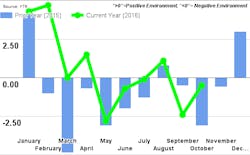Current conditions for shippers could best be described as the calm before the storm, according to transportation forecasting firm FTR. The company’s most recent Shippers Conditions Index (SCI), for October 2016, indicated a neutral reading of 0.4.
The Shippers Conditions Index is a compilation of factors affecting the shippers transport environment. Any reading below zero indicates a less-than-ideal environment for shippers.
The current reading of 0.4 reflects what FTR describes as “a pause before the index begins an expected decline in 2017, with the implementation of capacity-constraining regulations and an uptick in shipping rates as the economy strengthens.” Shippers can expect a couple more months of neutral market conditions until the bottom falls out and the SCI begins a downward spiral that could last for two years.
“Market activity for trucking is beginning to improve, a combination of higher volumes and less truck capacity in operation,” says Jonathan Starks, chief operating officer at FTR. “This trend should continue and will lead to higher rates and the potential for lower service levels. If you view the spot market as an early indicator, then we have seen steady improvement in loads and rates since Fall 2016.”
Shippers likely won’t be impacted until well into 2017, Starks believes. “Contract rates are still low and higher movement in this arena isn’t likely until after the winter bid season.” He doesn’t expect to see any significant improvement in contract rates until the latter half of 2017 since the real capacity issues stem from the electronic logging device (ELD) implementation scheduled for the end of 2017.
Meanwhile, according to a separate analysis undertaken by Cass Information Systems, freight shipments in December 2016 were up 3.5% compared to December 2015. Freight expenditures, on the other hand, were down -3.0% year-over-year.
The increase in volumes can be attributed to “outstanding rates of growth” from e-commerce, particularly for the holiday season.
“The trucking industry provides one of the more reliable reads on the pulse of the domestic economy, as it gives us clues about the health of both the manufacturing and retail sectors” asserts Donald Broughton, senior transportation analyst with Avondale Partners, in his analysis of the Cass Freight Index. “As the first industrial-led recovery (2009-2014) since 1961 came to an end, and the shift from brick-and-mortar retailing to e-commerce/omni-channel continues, we are becoming more focused on the number of loads moved by truck and less focused on the number of tons moved by truck.”
While tonnage is growing, the number of truckloads has declined on a year-over-year basis five out of the last seven months of 2016, Broughton notes. “No matter how it is measured, the data coming out of the trucking industry has been both volatile and uninspiring.”




